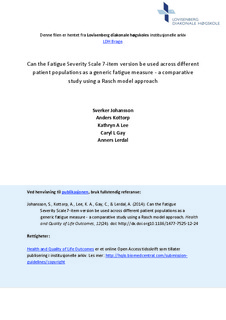| dc.contributor.author | Johansson, Sverker | |
| dc.contributor.author | Kottorp, Anders | |
| dc.contributor.author | Lee, Kathryn A | |
| dc.contributor.author | Gay, Caryl L | |
| dc.contributor.author | Lerdal, Anners | |
| dc.date.accessioned | 2016-10-12T08:49:28Z | |
| dc.date.available | 2016-10-12T08:49:28Z | |
| dc.date.issued | 2014-02-22 | |
| dc.identifier.citation | Johansson, S., Kottorp, A., Lee, K. A., Gay, C., & Lerdal, A. (2014). Can the Fatigue Severity Scale 7-item version be used across different patient populations as a generic fatigue measure - a comparative study using a Rasch model approach. Health and Quality of Life Outcomes, 12(24). doi: http://dx.doi.org10.1186/1477-7525-12-24 | nb_NO |
| dc.identifier.issn | 1477-7525 | |
| dc.identifier.uri | http://hdl.handle.net/11250/2414450 | |
| dc.description.abstract | Background: Fatigue is a disabling symptom associated with reduced quality of life in various populations living with chronic illnesses. The transfer of knowledge about fatigue from one group to another is crucial in both research and healthcare. Outcomes should be validly and reliably comparable between groups and should not be unduly influenced by diagnostic variations. The present study evaluates whether the Fatigue Severity Scale 7-item version (FSS-7) demonstrates similar item hierarchy across people with multiple sclerosis, stroke or HIV/AIDS to ensure valid comparisons between groups, and provide further evidence of internal scale validity.
Methods: A secondary comparative analysis was performed using data from three different studies of three different chronic illnesses: multiple sclerosis, stroke and HIV/AIDS. Each of these studies had previously concluded that the FSS-7 has better psychometric properties than the original FSS for measuring fatigue interference. Data from 224 people with multiple sclerosis, 104 people with stroke and 316 people with HIV/AIDS were examined. Item response theory and a Rasch model were chosen to analyze the similarity of the FSS-7 item hierarchy across the three diagnostic groups.
Results: Cross-sample differences were found for items #3, #5, #6 and #9 for two of the three samples, which raise questions about item validity across groups. However, disease-specific and disease-generic Rasch measures were similar across samples, indicating that individual fatigue interference measures in these three chronic illnesses might still be reliably comparable using the FSS-7.
Conclusions: Some items performed differently between the three samples but did not bias person measures, thereby indicating that fatigue interference in these illnesses might still be reliably compared using FSS-7 scores. However, caution is warranted when comparing fatigue raw sum scores directly across diagnostic groups using the FSS-7. Further studies of the scale are needed in other types of chronic illnesses.
Keywords: Acquired immunodeficiency syndrome, Fatigue, HIV, Multiple sclerosis, Rasch analysis, Questionnaire, Stroke | nb_NO |
| dc.language.iso | eng | nb_NO |
| dc.publisher | BioMed Central | nb_NO |
| dc.rights | Attribution-NonCommercial-NoDerivatives 4.0 Internasjonal | * |
| dc.rights.uri | https://creativecommons.org/licenses/by-nc-nd/4.0/ | * |
| dc.subject | Tretthet | nb_NO |
| dc.title | Can the Fatigue Severity Scale 7-item version be used across different patient populations as a generic fatigue measure - a comparative study using a Rasch model approach | nb_NO |
| dc.type | Journal article | nb_NO |
| dc.type | Peer reviewed | nb_NO |
| dc.source.pagenumber | 10 s. | nb_NO |
| dc.source.volume | 12 | nb_NO |
| dc.source.journal | Health and Quality of Life Outcomes | nb_NO |
| dc.source.issue | 24 | nb_NO |
| dc.identifier.doi | 10.1186/1477-7525-12-24 | |
| dc.identifier.cristin | 1117718 | |

